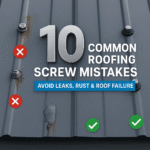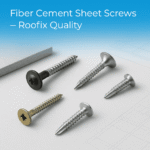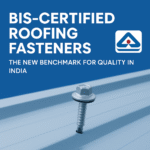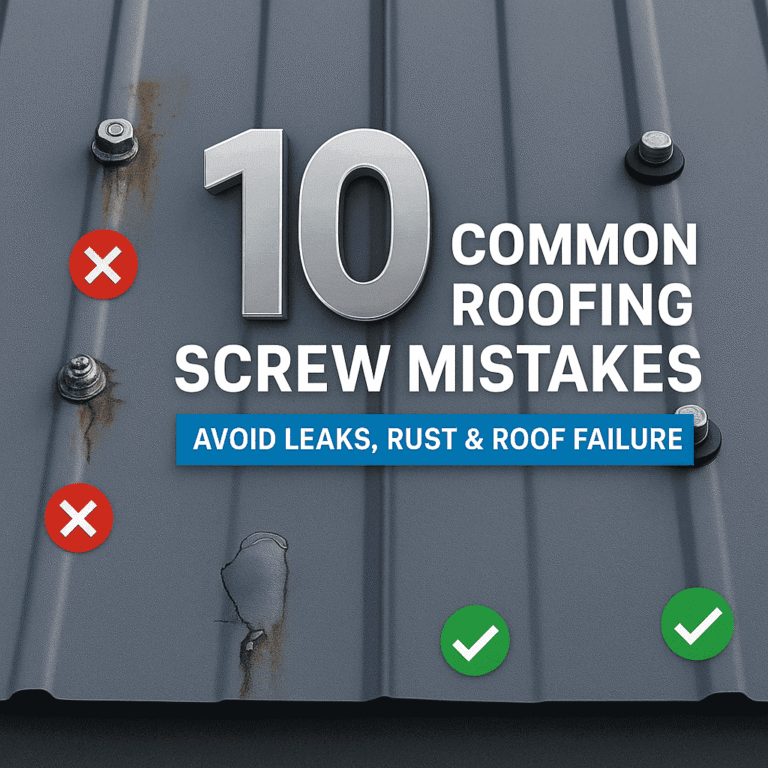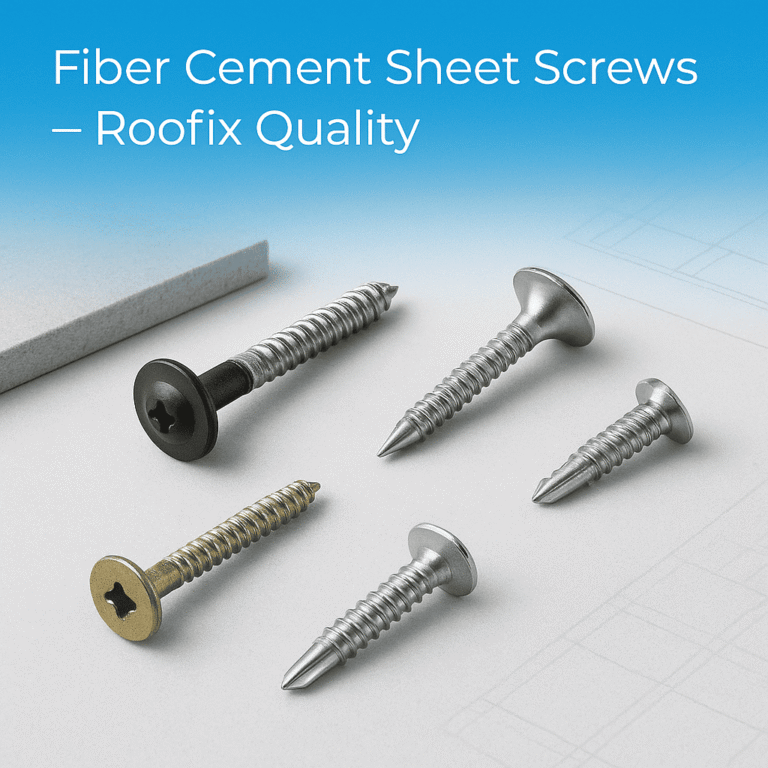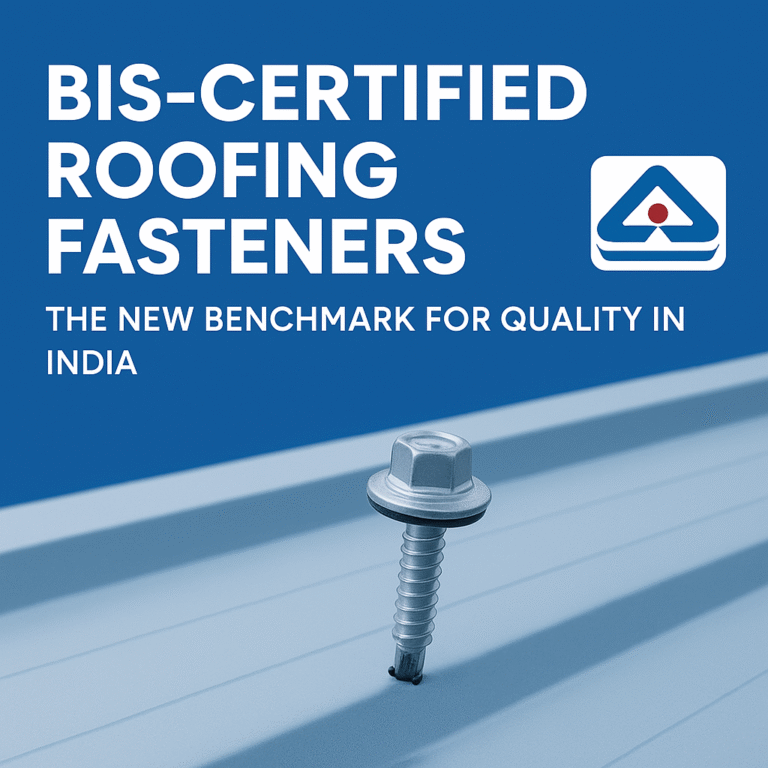What Makes a Good Wood Screw? A Buyer’s Guide for Roofing Contractors
What Makes a Good Wood Screw? A Buyer’s Guide for Roofing Contractors
- Roofix
Introduction
In roofing, every component matters — but fasteners often don’t get the attention they deserve. Whether you’re installing metal sheets on timber battens or fixing purlins to wooden frames, the right wood screw can make or break the integrity of your entire structure.
Choosing the wrong type of screw can lead to a cascade of problems: loose fittings, rust streaks, premature structural failure, or even damaged roofing sheets. Especially in high-stakes environments like industrial sheds, warehouses, or commercial roofs, contractors can’t afford shortcuts when it comes to fasteners.
This guide breaks down everything roofing professionals need to know about wood screws — from their design and materials to types, applications, and buying tips. We’ll also answer frequently asked questions, explain how to avoid common mistakes, and help you select the right screws for every kind of timber-to-metal or timber-to-sheet installation.
Understanding Wood Screws

What Are Wood Screws?
Wood screws are specially designed fasteners with a coarse, tapered thread intended for anchoring into timber, plywood, or other wood-based substrates. They provide strong holding power by cutting into the wood as they are driven in, offering superior grip compared to nails or general-purpose screws.
These screws are commonly used in roofing to fix metal sheets to timber battens, attach cladding, or secure frame structures. Unlike drywall or metal screws, wood screws are designed to minimize wood splitting and ensure long-term durability even under stress.
Self-Drilling vs Pre-Drilled Wood Screws
Not all wood screws are the same — especially when it comes to time-saving efficiency. Roofing contractors typically choose between:
| Screw Type | Drilling Method | Ideal For |
|---|---|---|
| Self-Drilling | No pilot hole needed | Fast roofing jobs, metal-to-wood fixing |
| Standard Wood Screws | Needs pre-drill | Precision jobs, aesthetic finishes |
Self-drilling wood screws (often called Tek screws) are commonly used in industrial or semi-commercial roofing because they combine drilling, tapping, and fastening in one step — saving time on site.
Key Components of a Wood Screw
Understanding how a wood screw is constructed helps in selecting the right one for each application:
Head: Common types include hex head (for high torque), flat head (flush fitting), and pan head (for decorative applications).
Drive Type: Hex, Phillips, or Torx — chosen based on torque control and drill compatibility.
Shank: The smooth portion above the threads that reduces friction during installation.
Threads: Coarse threads grip better in softwoods; fine threads are for hardwoods.
Tip: Self-drilling tips eliminate the need for pre-drilling.
Why Roofing Requires Specialized Wood Screws
Roofing contractors face a unique set of challenges:
Exposure to weather extremes
Fixing through metal sheeting into wood
Working on angled or elevated surfaces
Need for rust-proof coatings (especially in coastal or industrial zones)
Therefore, not all wood screws are suitable. For example, a standard interior-grade screw will corrode rapidly outdoors, compromising your roof’s integrity.
Roofing-grade wood screws, such as those offered by Roofix, are typically made from case-hardened carbon steel and coated with anti-corrosive layers like Zinc+Epoxy or Ruspert, ensuring performance and longevity.
What Makes a Wood Screw “Good” for Roofing?

Not all screws are built the same — and roofing, unlike furniture or cabinetry, demands heavy-duty performance under stress, moisture, and time. Here are the non-negotiable features that define a high-quality roofing wood screw:
1. Material & Core Strength
Case-Hardened Carbon Steel (AISI 1022): Most trusted for roofing applications because of its strength and drillability.
Stainless Steel: Corrosion-resistant but softer than carbon steel — often used in decorative or lightweight cladding.
Brass/Aluminum: Rarely used in roofing due to poor strength and corrosion concerns.
Roofix Tip: For long-term durability, go for case-hardened screws with verified mechanical strength. Avoid cheaper soft metal alternatives.
2. Anti-Corrosion Coating
Roofing screws are constantly exposed to sun, rain, and pollutants. That’s why coating matters.
| Coating Type | Benefit |
|---|---|
| Zinc-Plated | Basic protection; suitable for indoor/short-term |
| Epoxy-Coated | High weather resistance; combats oxidation |
| Ruspert Coating | Multi-layer system; best for coastal or industrial zones |
| Roofix Rust Shield | Tested against AS 3566-2002 Class 3 standard; optimal corrosion resistance |
3. Head Type: Drive Control & Aesthetics
Hex Flange Head: Offers better torque control, common in roofing jobs.
Wafer Head: For flush finishes in façade or cement board fixing.
Pan/Flat Head: More aesthetic, less torque control — rare in roofing.
Bugle Head: Self-countersinking; ideal for drywall, not roofing.
🔧 Roofix Recommendation: Use hex head wood screws for high-torque applications and faster installation using a Makita FS2700 or similar screwdriver drill.
4. Threading: Grip and Pull-Out Strength
Full Thread: For thin material or sheet-on-sheet applications
Partial Thread: For deep anchoring into timber
Coarse Thread: Offers better grip in softwoods
Fine Thread: Better suited to dense hardwoods
5. Tip Style: Speed & Accuracy
Self-Drilling (Tek): Saves time by eliminating the need for pilot holes
Self-Tapping: Cuts its own thread, but needs a pre-drill
Winged Tip: Ideal for fixing polycarbonate over timber — cuts thermal holes
6. Washer Integration
EPDM washers ensure leak-proof installation when roofing sheets are involved. These washers flex with thermal expansion and seal screw holes against water ingress.
| Washer Type | Use Case |
|---|---|
| 16mm EPDM | Regular roofing screw installations |
| 26mm EPDM | For polycarbonate and soft sheet surfaces |
| Without washer | Only for internal timber-to-timber fixings |
Types of Wood Screws Used in Roofing
Let’s categorize the most commonly used wood screws for roofing purposes:
| Type of Screw | Application | Head Type | Coating |
|---|---|---|---|
| Self-Drilling Wood Screw | Metal roofing to timber battens | Hex Head | Rust Shield |
| Wafer Head Wood Screw | Cement boards on wood frames | Wafer Head | Epoxy Coated |
| Wing-Tip Screws | Polycarbonate sheets on timber | Hex Head | Ruspert |
| Colored Head Screws | Visible roofs requiring aesthetic finish | Hex/Wafer | Powder Coated |
| Wood-to-Wood Screws | Joining timber elements (non-metal use) | Bugle Head | Zinc Plated |
Common Use Cases of Wood Screws in Roofing
Wood screws are essential where metal meets timber — especially in semi-commercial and industrial roofing environments across India. Below are common real-world applications:
| Use Case | Screw Type | Notes |
|---|---|---|
| Fixing metal roofing sheets to timber battens | 14G Self-Drilling Wood Screws | Most common application |
| Securing polycarbonate sheets on wood frames | Wing-tip Screws + EPDM Washers | Prevents cracking from thermal expansion |
| Mounting purlins or trusses to wood structures | High-strength Hex Head Screws | Choose proper length and coating |
| Installing accessories like vents or skylights | Epoxy-coated Wood Screws | For exterior elements exposed to heat and rain |
| Repair jobs on old wooden rafters | Partial-thread Screws | Provides deeper penetration into aged wood |
Best Practices for Using Wood Screws in Roofing
Pre-drill when necessary
While self-drilling screws eliminate the need for pre-drilling, if you’re working with hardwoods or aged timber, a small pilot hole reduces risk of splitting.Use torque-controlled screwdrivers
Use tools like the Makita FS2700 to avoid over-driving, stripping, or breaking screws.Always match screw length to timber thickness
Rule of thumb: Screw length should penetrate at least 2x the thickness of the roofing sheet into the wood.Choose the right washer for waterproofing
Never skip the EPDM washer in exposed roofing jobs — it’s your roof’s first line of leak defense.Check local wind load guidelines
Don’t rely on visual judgment for screw spacing. Refer to IS codes or consult professionals for your region’s wind load specs.
Mistakes Roofing Contractors Should Avoid
| Mistake | Consequence | Better Practice |
|---|---|---|
| Using drywall screws or low-grade screws | Rust, breakage, and structural failure | Always choose screws tested to AS 3566-2002 Class 3 |
| Ignoring washer quality | Leaks, rust streaks, and loose sheets | Use premium EPDM washers like DEKS TrueBlue |
| Wrong thread pitch for wood type | Poor grip, slippage, or splitting | Coarse thread for softwoods, fine thread for hardwoods |
| Overdriving screws | Damaged washers, loose hold, and stress cracks | Use a drill with depth control settings |
| Incorrect spacing of screws | Uplift during high winds, flapping, or sheet loss | Follow calculated screw pattern based on load and span |
Wood Screws vs Self-Drilling Screws: What’s the Difference?
| Feature | Wood Screws | Self-Drilling Screws |
|---|---|---|
| Target Material | Timber, plywood | Steel, metal sheets |
| Tip Type | Self-drilling or standard | Self-drilling (TEK Point) |
| Head Type | Hex / Wafer / Bugle | Hex / Wafer |
| Drilling Requirement | May need pilot hole for hardwood | No pilot hole needed |
| Use in Roofing | Metal to timber | Metal to metal or cement boards |
| Example Product | Roofix 14G Wood Screws | Roofix 14G Metal Screws with Rust Shield |
How to Choose the Right Wood Screw for Roofing Jobs
Not all wood screws are created equal. As a contractor, here’s a checklist to guide your selection:
| Feature | What to Look For | Why It Matters |
|---|---|---|
| Material | Case-hardened carbon steel (AISI 1022) | Stronger, durable, and more impact-resistant |
| Coating | Multi-layer Rust Shield or Zinc + Epoxy | Prevents corrosion in humid and coastal environments |
| Head Type | Hex Flange Head with integral washer | Better control, tighter grip, and clean finish |
| Thread Design | Deep, coarse threads | Superior hold in timber structures |
| Length Options | 32mm to 58mm depending on substrate thickness | Ensures deep penetration without sheet damage |
| Washer Compatibility | EPDM or DEKS TrueBlue | Maintains waterproof seal and resists UV deterioration |
| Tool Compatibility | Makita FS2700 or similar screwdriver (max 2500 RPM) | Avoids stripping, overdriving, or head breakage |
When Should You Use Wood Screws vs Other Fasteners?
| Material/ Structure Type | Recommended Fastener | Example Application |
|---|---|---|
| Timber trusses | Wood Screws | Metal sheet to wooden purlins |
| Polycarbonate roofing | Polycarbonate Screws | With thermal expansion wing design |
| Cement boards to steel | Wafer Head Screws | Façades or wall lining |
| Overlapping metal sheets | Stitch Screws | For side-laps in high wind zones |
| Concrete structures | Anchors/Bolts | Heavy load-bearing components |
Roofing Wood Screws – FAQs
Typically, 14G (6.3mm diameter) screws are used, with lengths ranging from 32mm to 58mm. Choose length based on the sheet and timber thickness.
Not by themselves. But when used with EPDM washers and coated with Rust Shield, they are highly water-resistant and suitable for roofing.
No. Ordinary screws lack corrosion protection and pull-out strength. Always use roofing-grade wood screws tested to AS 3566-2002 standards.
A torque-controlled drill like the Makita FS2700 is ideal. It prevents overdriving and works well with self-drilling screws.
This varies by sheet size, wind zone, and manufacturer guidelines. A typical estimate is 10–12 screws per 3-meter sheet.
Final Thoughts: Invest in Quality, Reap Long-Term Rewards
Choosing the right wood screw for your roofing project is about more than compatibility — it’s about longevity, safety, and performance.
Whether you’re fixing metal sheets to timber or working with complex roofing geometries, Roofix offers screws engineered for real-world construction conditions. With corrosion resistance, strength, and installer-friendly design, our screws ensure your projects stay secure for years to come.
Explore Our Range of Wood Screws → Roofix Wood Screws
Have a Question? Contact the Roofix Team
Share on :
Recent posts
10 Common Roofing Screw Mistakes That Can Ruin…
Everything You Should Know About Fiber Cement Sheet…
BIS-Certified Roofing Fasteners: Setting the New Standard for…
Get a free Estimate
Related Posts
10 Common Roofing Screw Mistakes That Can Ruin Your…
10 Common Roofing Screw Mistakes That Can Ruin Your Project (And How to Avoid Them)…
Everything You Should Know About Fiber Cement Sheet Screws
Everything You Should Know About Fiber Cement Sheet Screws Everything You Should Know About Fiber…
BIS-Certified Roofing Fasteners: Setting the New Standard for Quality…
BIS-Certified Roofing Fasteners: Setting the New Standard for Quality in India BIS-Certified Roofing Fasteners: Setting…

